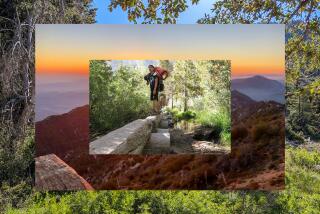Drive for Tourism, Recognition Has Lancaster Pushing Poppies : Festival: City officials plan an ambitious merchandising campaign and an expanded event for the state flower.
LANCASTER — Mention the Tournament of Roses, and you think of Pasadena. Talk about garlic, and Gilroy comes to mind. Bring up poppies, and you think of the Emerald City in “The Wizard of Oz.”
But if Lancaster officials have their way, this city will become just as closely associated with the delicate, papery bloom--specifically California poppies, the state flower.
To make that happen, Lancaster is planning an ambitious merchandising campaign and an expanded spring festival, both centering on the bright orange flowers. Lancaster officials want to sell their California Poppy Festival mugs, pins and T-shirts throughout the state to promote the city and attract tourists.
But the wild card in their plan is Mother Nature.
Because its winter rainfall and temperatures vary dramatically, Lancaster can’t always count on a big, blazing display of spring poppies at the state wildflower sanctuary just west of the city. Camera-toting tourists who find little more than desert weeds there may not return.
The solution, Lancaster officials believe, is to till, seed and water some of the soil in and near the park to nudge along nature.
Vic Maris, who manages the 1,750-acre Antelope Valley California Poppy Reserve, is cooperating with the city.
“We both have the same goals,” said Maris, a district superintendent for the California Department of Parks and Recreation. “A bad crop of flowers means we’ve both failed.”
After years of refusing to interfere with natural poppy growth, the state changed course last year by setting fire to 15 acres at the reserve after the wildflower season ended. The goal was to burn off the tall, wild grass that has been stealing the ground water and sunshine that poppies need to sprout.
Then, an accidental fire charred another 300 acres at the reserve last fall, inadvertently expanding the experiment.
Usually, wildflowers are the first plants to re-emerge after a fire, and park officials are eager to see if that will happen this spring.
Such intrusions may sound as though they take the wild out of wildflowers, but park officials and several nature experts are welcoming the effort after a disappointing display last year.
A shortage of winter rain, a spring heat wave and competition from weeds at the reserve resulted in a meager showing of poppies that lasted only a week or two, noted Holliday Wagner, executive director of the Theodore Payne Foundation for Wildflowers and Native Plants.
Wagner, who has a doctorate in plant ecology, said she would not object if officials foster the growth of poppies in a limited part of the state park. The purist Payne Foundation itself plants and waters wildflowers on a hill near its Sun Valley headquarters, for educational purposes.
But there’s a right way and a wrong way to improving on nature, Wagner warned. If state officials decide to do plant part of the Antelope Valley reserve, she said, they should not import seeds from central California because that would contaminate the high desert’s floral gene pool.
Planting additional seeds may not even be necessary, she said, because the park’s soil has plenty of dormant ones. “They don’t have to do the seeding,” she said. “They just have to do the watering.”
Wagner said the minimal work should ensure that some poppies sprout each year--and that tourism and wildflower appreciation will flourish as well.
“Part of it is to get people out there to appreciate the natural environment,” Wagner said. “You’re trying to say, ‘This is what you’re going to be losing if the whole Antelope Valley goes up in housing.’ ”
Local nature buffs are also enthused about the change of philosophy at the poppy park.
“I think it’s about time,” said Milt Stark, a photographer who has published a guidebook for Antelope Valley wildflower fans.
The Lancaster resident said he led an advisory committee more than a dozen years ago that urged state parks officials to give the poppies a hand.
“We recommended the reserve be used for experimental work to find out what would promote the growth of wildflowers--poppies in particular,” Stark said.
*
“When we have good wildflower years, a whole lot of people come to Lancaster,” Stark said. “The whole wildflower scene has put Lancaster on the map.”
That’s just what city officials have in mind.
Last April, about 50,000 people attended Lancaster’s third annual California Poppy Festival. The two-day event was set up at Lancaster City Park but offered bus and helicopter rides to the poppy reserve.
Though many visitors were out-of-towners, few stayed overnight, to the dismay of local hotel and restaurant owners. So Lancaster officials want to expand the activities and step up their marketing blitz this spring so that the poppy event becomes as well-known as the Gilroy Garlic Festival, which attracts 250,000 visitors annually.
“Our T-shirts are going to be for sale at K marts in Palmdale and Lancaster,” said Lyle Norton, the city’s parks, recreation and arts director. “Our ultimate goal would be to have our merchandise in K marts outside the Antelope Valley.”
In early January, Norton and Lancaster Mayor Frank Roberts flew to Sacramento to talk to state parks officials about joint projects with the poppy reserve and placing the city’s poppy souvenirs in state gift shops.
Norton said they received a warm reception, largely because their event salutes the state flower.
“If we had the ‘rooster festival,’ ” Norton said, “they would not have been interested in us.”
More to Read
Sign up for The Wild
We’ll help you find the best places to hike, bike and run, as well as the perfect silent spots for meditation and yoga.
You may occasionally receive promotional content from the Los Angeles Times.






